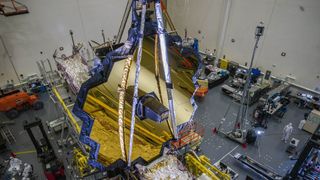NASA estimates COVID-19 pandemic will cost the agency $3 billion, plus delays

More than a year into a pandemic that has killed nearly 3 million people worldwide, NASA estimates that COVID-19 will cost the agency perhaps as much as $3 billion.
In a report from the NASA Office of Inspector General published March 31, agency personnel compiled the pandemic's impact on dozens of projects, ranging from aircraft development to space station missions to new planetary science spacecraft. The James Webb Space Telescope, the Nancy Grace Roman Space Telescope and the Space Launch System rocket have been particularly hard-hit, the report notes; Europa Clipper, the Orion crew capsule, and the Plankton, Aerosol, Cloud, Ocean Ecosystem (PACE) mission also get special mention.
"A top-line estimate of the cost for these delays and challenges across NASA is estimated to be nearly $3 billion. However, NASA will not be able to quantify the complete impact of the pandemic on its programs and projects until after the COVID-19 emergency has subsided," the report reads. "In addition to cost impact, launch dates for several NASA missions have been delayed between 1 and 10 months."
Related: Coronavirus pandemic: Full space industry coverage
The report includes individual analyses for 18 different agency projects, digging into the specific impacts of COVID-19 and highlighting budget and timeline issues caused by the pandemic and the public health measures that have been implemented to slow its spread. Of those, 12 are classified as "significantly" impacted.
Some of those challenges have come to projects that have long struggled with timelines. The pandemic forced NASA to delay the launch of its James Webb Space Telescope yet again, pushing the target launch date from March 2021 to Oct. 31. But Webb is far from alone in facing delays.
The launch of the agency's next major space telescope, the Nancy Grace Roman Space Telescope, will also be delayed by about six months, from December 2025 to June 2026, due to "inefficiencies, late contractor deliveries, and late delivery of government-furnished equipment," the report notes.
Get the Space.com Newsletter
Breaking space news, the latest updates on rocket launches, skywatching events and more!
Facility closures have stymied the agency's Low-Boom Flight Demonstrator, a project developing an aircraft called the X-59 that flies faster than the speed of sound but doesn't produce a sonic boom. NASA estimates that the first flight of the X-59 will be delayed by four months, although it doesn't specify a new target launch date.
The launch delays are staggering.
The NASA-ISRO Synthetic Aperture Radar (NISAR), an Earth-observing collaboration with the India Space Research Organisation, will launch about seven months later than previously planned, in January 2023 instead of June 2022. The launch of PACE, a second Earth-observing satellite, will be delayed by about nine months, to December 2023 from March 2023. The Spectro-Photometer for the History of the Universe, Epoch of Reionization and Ices Explorer (SPHEREx) will launch about 10 months later than previously planned, in June 2024 rather than September 2023.
And the agency will probably face still more launch delays and costs, the report emphasized. "Due to the continued uncertainties around the COVID-19 pandemic, NASA will likely continue to experience impacts to its major programs and projects."
Email Meghan Bartels at mbartels@space.com or follow her on Twitter @meghanbartels. Follow us on Twitter @Spacedotcom and on Facebook.
Join our Space Forums to keep talking space on the latest missions, night sky and more! And if you have a news tip, correction or comment, let us know at: community@space.com.

Meghan is a senior writer at Space.com and has more than five years' experience as a science journalist based in New York City. She joined Space.com in July 2018, with previous writing published in outlets including Newsweek and Audubon. Meghan earned an MA in science journalism from New York University and a BA in classics from Georgetown University, and in her free time she enjoys reading and visiting museums. Follow her on Twitter at @meghanbartels.